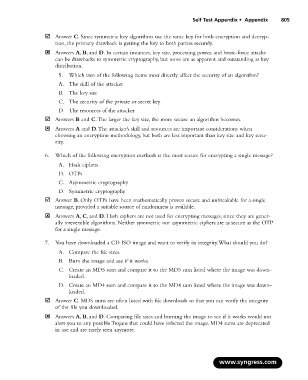Page 821 - StudyBook.pdf
P. 821
Self Test Appendix • Appendix 805
Answer C. Since symmetric key algorithms use the same key for both encryption and decryp-
tion, the primary drawback is getting the key to both parties securely.
Answers A, B, and D. In certain instances, key size, processing power, and brute-force attacks
can be drawbacks to symmetric cryptography, but none are as apparent and outstanding as key
distribution.
5. Which two of the following items most directly affect the security of an algorithm?
A. The skill of the attacker
B. The key size
C. The security of the private or secret key
D. The resources of the attacker
Answers B and C.The larger the key size, the more secure an algorithm becomes.
Answers A and D.The attacker’s skill and resources are important considerations when
choosing an encryption methodology, but both are less important than key size and key secu-
rity.
6. Which of the following encryption methods is the most secure for encrypting a single message?
A. Hash ciphers
D. OTPs
C. Asymmetric cryptography
D. Symmetric cryptography
Answer B. Only OTPs have been mathematically proven secure and unbreakable for a single
message, provided a suitable source of randomness is available.
Answers A, C, and D. Hash ciphers are not used for encrypting messages, since they are gener-
ally irreversible algorithms. Neither symmetric nor asymmetric ciphers are as secure as the OTP
for a single message.
7. You have downloaded a CD ISO image and want to verify its integrity.What should you do?
A. Compare the file sizes.
B. Burn the image and see if it works.
C. Create an MD5 sum and compare it to the MD5 sum listed where the image was down-
loaded.
D. Create an MD4 sum and compare it to the MD4 sum listed where the image was down-
loaded.
Answer C. MD5 sums are often listed with file downloads so that you can verify the integrity
of the file you downloaded.
Answers A, B, and D. Comparing file sizes and burning the image to see if it works would not
alert you to any possible Trojans that could have infected the image. MD4 sums are deprecated
in use and are rarely seen anymore.
www.syngress.com

